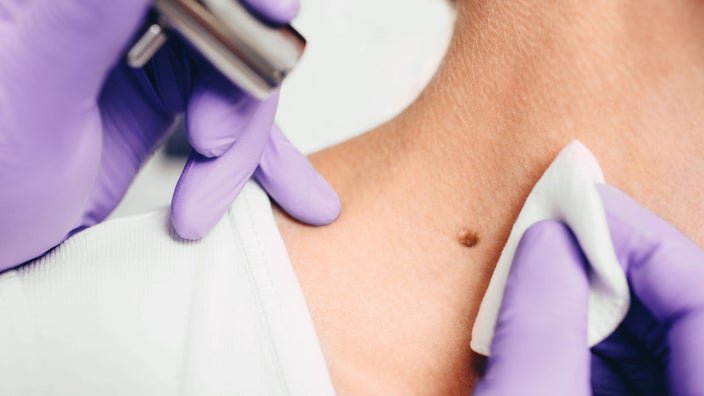
How Much Does Mole Removal Cost?
Key takeaways:
The cost of mole removal varies based on factors such as size, placement, and treatment method.
The cost to remove a mole often ranges from about $150 to more than $1,500. If you’re having a mole removed for cosmetic reasons, you’ll have to pay out of pocket.
Typically, your health insurance plan will cover mole removal if it’s medically necessary because of a cancer risk.
Table of contents

Most people have moles, and most are normal and harmless. A mole, also known as a nevi, can be brown, tan, or black and either flat or raised. Moles may be tiny or larger than a pencil eraser (5 mm).
If you're not happy with a mole and want it removed for cosmetic reasons, you'll have to pay out of pocket. Insurance doesn't cover mole removal for cosmetic reasons.
However, if a doctor determines a mole to be suspicious for development of skin cancer, insurance will generally cover all or part of the removal cost.
Search and compare options
In this piece, we will discuss removing moles for cosmetic reasons or because of cancer risk.
Some moles are removed because of a cancer diagnosis, which we will not explore here.
Types of moles
There are several types of moles. Some of the most common are:
Benign moles: Benign moles are the most common. They are not cancerous and don’t need to be removed for medical reasons.
Atypical moles: Atypical moles or dysplastic nevi are more likely to turn into skin cancer. They tend to be larger, and have irregular shapes and uneven color. They also may itch or bleed and grow quickly.
Congenital moles: Congenital moles are present at birth or show up within 2 or 3 years. They often are harmless, but some can turn into skin cancer. Some congenital moles need to be removed to avoid cancer. Others need to be removed for cosmetic concerns.
Any mole that is irregular in shape, bleeding, or painful should be evaluated for possible treatment.
Make sure to prepare a list of questions for your visit with a doctor. This can help guide the discussion about the best options for your mole or moles. And it can help you decide whether mole removal would be worthwhile for your situation.
Here are some sample questions:
Is my spot a mole or a freckle?
What characteristics should I watch for in a mole?
Does my mole look suspicious for cancer?
How can I lower my risk of skin cancer?
How often should I have my mole checked?
Does this mole need to be removed?
Can you remove a mole yourself? Different commercial products claim to remove moles at home. But do they work? And are they safe?
What does skin cancer look like? Skin cancer usually shows up as a visible change in your skin — but it’s not always a mole. See pictures that can help you spot skin cancer early, when it’s most curable.
Insurance coverage for skin care: If you have insurance, some dermatology treatments may be covered when deemed medically necessary. Here’s what you need to know about coverage for common procedures — and what to do if a service isn’t covered.
How are moles removed?
Moles can be removed in a wide variety of ways:
Surgical excision: This method is often used for large or deep moles and requires stitches.
Surgical shaving: The top layers of the mole are removed with a medical razor blade. The procedure is usually followed with some ointment or cauterization to stop the bleeding.
Punch excision: A tiny tool that resembles a cookie cutter removes a deeper amount of tissue than shaving does. This procedure may require stitches.
Laser removal: Bursts of light radiation are used to destroy the mole. This method is best suited for small, flat, non-cancerous moles.
Freezing: Liquid nitrogen can be used to freeze some non-cancerous, shallow moles. This procedure may cause blistering afterward.
Mole removal is usually done on an outpatient basis. Multiple treatments are sometimes required.
Read more like this
Explore these related articles, suggested for readers like you.
A dermatologist can examine your mole to see whether it's harmless or possibly cancerous and to find the best removal method. You may need to see a special kind of dermatologist called a Mohs surgeon. Mohs surgeons remove skin cancer growths and larger moles.
After it’s removed, your mole will be sent to a lab. A pathologist will look at your mole to see if there are any signs of cancer.
How much does it typically cost to remove a mole?
Mole removal will be based on size, location on the body, and your doctor’s specialty and experience — among other factors. This is why the cost of mole removal varies widely.
Generally, the cost to remove a mole often ranges from about $150 to more than $1,500.
Here are some sample costs:
On the website of facial plastic surgeons in the Dallas, Texas area, the cost of mole removal is reported as $300 to $500 per lesion and as much as several thousand dollars.
A multi-office dermatology practice in the greater Memphis, Tennessee area lists the cost of mole removal as $150 to $2,000 on its website.
A triple-board-certified plastic surgeon in the Houston area charges $150 to $500 for mole removal.
A surgeon-run laser center in suburban Nashville charges $150 to $1,500 for laser mole removal.
Charges for freezing flat moles start at $80 for 1 and can be as much as $250 for 15 or more moles at a 2-office laser center run by dermatologists in the Los Angeles area. Freezing may require more than one treatment.
Does insurance cover mole removal?
Sometimes. Most moles are benign, and insurance will not cover mole removal for cosmetic reasons. However, commercial insurance plans and Medicare Advantage plans typically cover the removal and biopsy of moles that are possibly cancerous. There usually are additional costs for pathology, which is the examination of those removed moles.
Original Medicare doesn’t cover cosmetic surgery and Medicaid doesn't either. However, these government insurance plans typically cover a mole removal that poses a cancer risk or for other medical reasons.
For instance, Medicare will cover mole removal if the procedure is considered medically necessary and is documented as such in the medical record.
Medical reasons for removing moles include:
Potential of cancer diagnosis
Bleeding
Intense itching
Pain
Change in appearance (reddening or pigment changes)
Recent enlargement
Greater number of moles
Evidence of inflammation or infection, such as oozing
Blocking an orifice, such as the mouth or nose
Limits in eye function
What are my options for paying out of pocket?
That depends on the mole as well as your needs and preferences.
Here are some things to keep in mind:
Most moles don't require treatment.
Removal might be worth it if the mole bothers you by rubbing against your clothing, catching on jewelry, or you don't like how it looks. In these cases, the procedure would be considered cosmetic, which means removal would not be covered by insurance.
You should see a doctor if you have a suspicious mole that could pose a cancer risk. This type of mole removal would be eligible for coverage under most insurance plans, including Medicare and Medicaid.
If your mole is normal and your reasons for wanting it removed are cosmetic, you will be responsible for removal costs.
Many doctors offer payment plans. Ask about the repayment terms and interest charges, if any. Some healthcare offices suggest CareCredit, a medical credit card. But, the interest charges will add to your total cost. Compare medical credit card rates with a regular credit card or personal loan, which may be cheaper.
Buy now, pay later
Another option is financing through a buy now, pay later (BNPL) short-term healthcare loan. BNPL loans let you pay the bill in installments, and typically require a down payment, such as 25% of the total bill. There may be no interest charges if you stick to the payment schedule. But, if you miss any payments, your fees and interest can start to add up fast.
Be sure to read and understand the terms and conditions before taking on a BNPL loan. In healthcare, these loans are sometimes called care now, pay later.
How long do the benefits of mole removal last?
Surgical excision usually removes the mole permanently. With surgical shaving or laser treatments, there is the possibility that the mole could grow back.
But, mole removal may bring lifelong benefits by making you feel better about your appearance or eliminating an annoyance.
The bottom line
Cosmetic mole removal can cost about $150 to more than $1,500 out of pocket, depending on the size, location, number of moles, and type of removal procedure. For benign moles, removal for cosmetic reasons is generally not covered by insurance. However, mole removal for medical reasons, such as symptoms that show a cancer risk, are typically eligible for insurance coverage.
Why trust our experts?



References
American Academy of Dermatology Association. (n.d.). Moles: Overview.
American Academy of Dermatology Association. (n.d.). Moles: Who gets and types.
Beaumont. (n.d.). Non-cancerous mole removal.
Cancer Treatment Centers of America. (2022). What to expect if you have a mole removed.
Centers for Medicare and Medicaid Services. (2022). Removal of benign skin lesions.
Dermatology and Laser Centre. (n.d.). Moles and lesions.
Franklin Skin and Laser. (n.d.). How much does it cost to remove a mole with a laser?
Lake, R. (2022). Buy Now, Pay Later (BNPL): What it is, how it works, pros and cons. Investopedia.
Levy Dermatology. (2019). How much does mole removal cost?
Medicare.gov. (n.d.). Cosmetic surgery.
Navarro-Fernandez, I. N., et al. (2022). Congenital nevus. StatPearls.
Plastic Surgery Institute of Southeast Texas. (n.d.). Mole removal procedure overview.
Texas Facial Aesthetics. (n.d.). Mole removal.
UC Health. (n.d.). Moles and other benign skin growths.
Wensley, K. E., et al. (2022). Atypical mole. StatPearls.
Winslow, T. (2022). Vulvar cancer treatment (PDQ). PDQ Cancer Information Summaries.





























